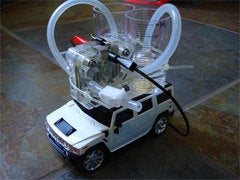How to make a fuel cell-powered RC car
It's bulky, but it's science.

What looks like a refugee from Mad Max is really a modified RC car that runs on water rather than conventional batteries. This proof of concept project gives you some practical meaningful experience using a fuel cell to generate usable electricity. Why wait for the Honda FCX Hydrogen Car when you can build your own working model prototype today?
Stats
- Time: 7 hours
- Cost: $132.23
- Difficulty: moderate
Parts
All fuel cell parts can be ordered from the Fuel Cell Store. Links for the exact parts are currently unavailable.
- 1:32 scale RC Hummer (RadioShack #60-250; $9.99)
- Double reversible fuel cell (Fuel Cell Store #1158-7110301; $67.50)
- 30-milliliter gas storage cylinders (Fuel Cell Store #1172-7110307; $7.50)
- 2 clamps (Fuel Cell Store #1174-623002; $1.85)
- 24-inch silicon tubing (Fuel Cell Store #1176-7110309; $3.25)
- Syringe (Fuel Cell Store #803-620600; $1.50)
- 5-volt DC-to-DC step up PCB (Spark Fun Electronics #PRT-08290; $9.95)
- 3-volt solar panel (Fuel Cell Store #951-621500; $20.50)
- 6 (2-millimeter) banana connectors (Mouser #565-5936-0; $0.70)
- 22-gauge hookup wire (RadioShack #278-1224; $5.99)
- Distilled water (local grocery store; $2.00)
Instructions
1. Convert the RC Hummer from battery power to fuel cell power. Install the 5-volt DC-to-DC step up circuit with the PCB modified for 3.3-volt output. Connect a pair of 2-millimeter banana connectors to the input terminals of the DC-to-DC step up PCB. Connect the PCBs output to the positive (+) and negative (-) terminals of the Hummer’s battery box.

2. Fill the gas storage cylinders with distilled water. Attach two 6-inch lengths of silicon tubing to the cylinders. Plug the other end of the hydrogen cylinder tubing into one of the tube stubs on the black terminal side of the fuel cell. Plug the other end of the oxygen cylinder tubing into one of the tube stubs on the red terminal side of the fuel cell. Attach two 2-inch lengths of tubing to the two remaining hydrogen side and oxygen side tube stubs.

3. Fill the fuel cell with water by drawing water out of the 2-inch tubing with the syringe. Repeat this process on both the hydrogen side and oxygen side of the fuel cell. Seal these short lengths with two clamps.

4. Connect the solar panel’s positive (+) terminal to the red, oxygen side of the fuel cell. Connect the solar panel’s negative (-) terminal to the black hydrogen side of the fuel cell. Place the solar panel in bright direct sunlight. The fuel cell will begin to produce both hydrogen and oxygen by electrolysis. In a low winter sun, this gas production process can take approximately 30 minutes to fill the two 30-milliliter cylinders.

5. When the cylinders are full of gas, disconnect the solar panel from the fuel cell. Connect the 5-volt DC-to-DC step up input to the positive (+) and negative (-) terminals of the fuel cell. The fuel cell will produce a rock-solid 2.2 volts of electricity.

6. Switch on the Hummer and drive around. You should expect about 12 minutes worth of driving from 30 milliliters of hydrogen/oxygen. When the gas is depleted, return to the “gas pump” in Step 4 and disconnect the Hummer and reconnect the solar panel for beginning the electrolysis process all over again.

Discover other, more practical, ways of using fuel cell technology to replace wasteful alkaline battery consumption.